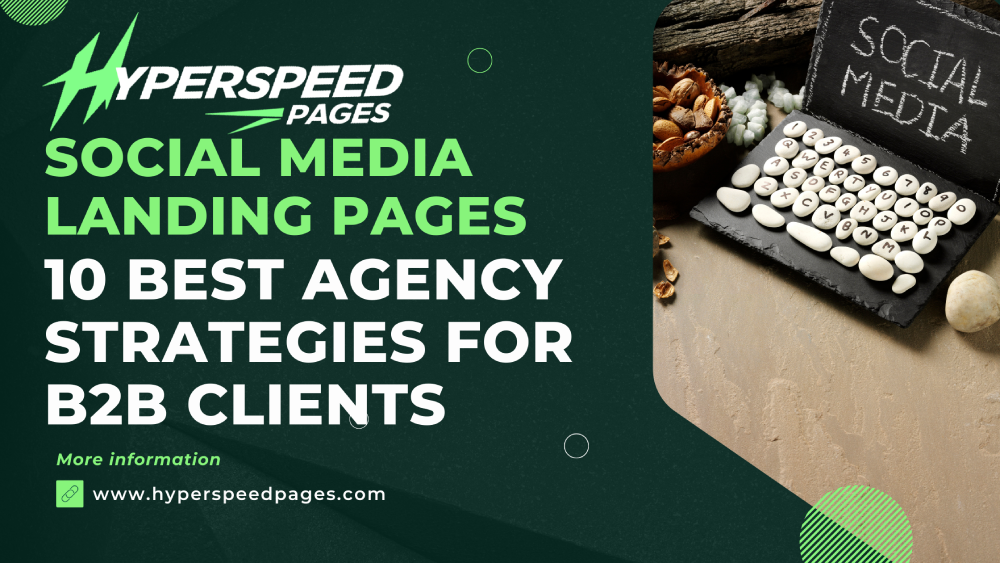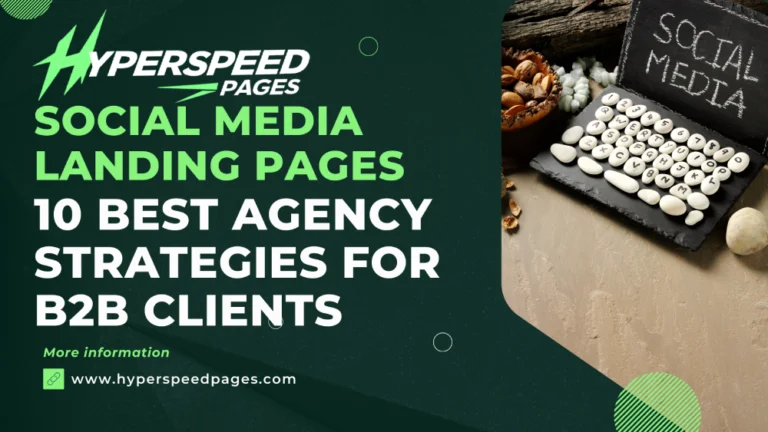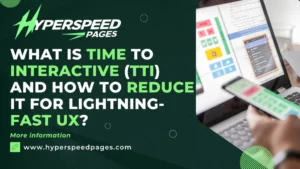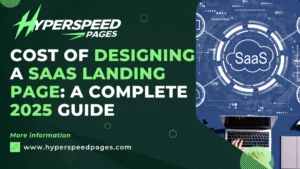
Strategy Social media marketing has become a cornerstone for any B2B (business-to-business) marketing strategy. From LinkedIn to Facebook, social media platforms offer a powerful way to reach potential clients, nurture relationships, and drive conversions. However, the real magic happens not on the social media platform itself, but on the landing page. A landing page is the endpoint where users are directed after clicking on a social media ad or post, and it plays a crucial role in converting those visitors into leads or clients.
Creating effective landing pages for B2B clients requires specialized strategies, as B2B buying decisions often involve more research, longer sales cycles, and multiple decision-makers. Here, we will look into best practices and strategies for agencies managing B2B clients, focusing on building high-performing social media landing pages that deliver results.
Why Are Landing Pages Important in B2B Social Media Campaigns?
Before diving into strategies, it’s essential to understand why landing pages are crucial for B2B social media marketing.
- Targeted Conversions: While social media ads can create interest and drive traffic, the landing page’s primary role is to convert that interest into a lead, inquiry, or sale. A poorly optimized landing page will result in wasted ad spend, no matter how well-designed your social media campaigns are.
- Data Collection: B2B transactions often require nurturing over time. Landing pages serve as critical touch-points where businesses collect essential information about potential clients, such as their company name, email, and job title.
- Brand Experience: A seamless user experience from social media to the landing page is key for creating trust and credibility. Inconsistent messaging or clunky design can turn potential clients away.
Now that we’ve established the importance of landing pages, let’s discuss the best strategies to create them for B2B clients.
Best Strategies for Creating Effective B2B Social Media Landing Pages
1. Focus on a Single Goal and CTA
The most effective B2B restaurant landing pages are designed with a single objective in mind. For B2B clients, this could be booking a demo, signing up for a newsletter, downloading a white paper, or requesting a quote. A landing page that tries to do too much, like offering multiple CTAs (Calls to Action), tends to confuse visitors and dilute the effectiveness of the page.
Best Practices:
- Clearly define the action you want the visitor to take.
- Use a bold, well-placed CTA button with action-oriented language, such as “Get Your Free Demo” or “Download the Guide.”
- Ensure that the CTA is visible without needing to scroll (above the fold).
2. Personalize the User Experience
Personalization in B2B marketing is vital. Every business is unique, so landing pages should reflect that. Use data from the social media platform to create personalized experiences that align with the visitor’s industry, job role, or company size.
Personalization Techniques:
- Dynamic Content: Use software tools like HubSpot or Unbounce that allow for dynamic landing pages, where the content changes based on the visitor’s company, role, or industry.
- Custom Messaging: If you know the user came from a LinkedIn ad targeting financial services professionals, tailor your messaging to speak directly to their specific pain points and solutions.
- Pre-filled Forms: For returning users or for those coming from platforms like LinkedIn, consider using pre-filled forms that make it easier for visitors to submit their information.
3. Optimize for Mobile
While many assume B2B buyers interact with content on desktop devices, mobile usage among business professionals is growing rapidly. According to several studies, nearly 70% of B2B buyers conduct some level of research on mobile before making a purchase decision. If your B2B SaaS landing page isn’t optimized for mobile, you risk losing a significant portion of your potential leads.
Mobile Optimization Tips:
- Ensure all forms, CTAs, and content are responsive.
- Avoid overly complex design elements that can slow down load times.
- Keep the copy concise and prioritize essential information for mobile users.
- Use large buttons that are easy to tap on smaller screens.
4. Build Trust with Testimonials, Case Studies, and Data
B2B decision-makers rely heavily on trust and credibility before making buying decisions. Landing pages should incorporate trust-building elements like customer testimonials, case studies, awards, or data that prove your client’s expertise.
Trust-Building Tactics:
- Include quotes or short testimonials from satisfied clients, especially those in the same industry as the target audience.
- Showcase recognizable logos of your client’s partners or previous clients.
- Feature statistics or data that demonstrate the success or efficacy of the product or service being offered.
- Use authoritative and trust signals like certifications, ISO standards, or security compliance icons, particularly if the offering involves sensitive data (e.g., cybersecurity services).
5. Use Simplified, Clear Forms
One of the key features of B2B landing pages is the lead capture form. However, asking for too much information can reduce conversion rates. Simplicity is key—only request the most necessary information at this stage of the process, such as name, company, and email.
Form Best Practices:
Keep the form short—ask for only 3-5 fields of information.
If necessary, use progressive profiling techniques to gather more data over time rather than in one sitting.
Use multi-step forms to break up the process into manageable sections, improving the user experience.
Ensure the form fields are easy to navigate on both desktop and mobile devices.
6. Maintain a Consistent Message
Consistency between your social media ad and the landing page is vital to keeping the visitor engaged. If there’s a disconnect between the messaging on the ad and the content on the landing page, potential clients may bounce off the page.
How to Ensure Consistency:
- Align Visuals: Use the same imagery, logos, and color schemes on the landing page as in the social media ad to create a seamless transition.
- Consistent Messaging: Ensure that the headline on the landing page reflects the promise or value proposition mentioned in the social media ad. For example, if the ad offers a “Free Consultation,” the landing page headline should reinforce that offer.
- Tone and Language: Maintain a consistent tone across the ad and landing page to prevent confusion or dissonance.
7. Leverage A/B Testing for Continuous Improvement
Landing pages are not a “set it and forget it” tactic. To get the best results, continually optimize through A/B testing, where you test different elements to see what works best for your audience.
What to Test:
- Headlines: Try different value propositions to see which resonates most with your audience.
- CTA Buttons: Test variations in size, color, placement, and text.
- Form Length: See if reducing or adding form fields impacts conversion rates.
- Social Proof Placement: Test where client logos or testimonials are most effective—above the fold, near the CTA, or at the bottom of the page.
8. Analytics and Tracking for Optimization
The success of any landing page lies in its performance data. Agencies must employ robust tracking mechanisms to analyze how visitors interact with the page, where they drop off, and what elements lead to conversions.
Essential Tracking Tools:
- Google Analytics: Used to track page views, bounce rates, and conversions.
- Heatmaps: Tools like Hotjar or Crazy Egg can show where visitors are clicking, scrolling, and dropping off, allowing for better design adjustments.
- CRM Integration: Ensure that all lead information is automatically fed into the client’s CRM for follow-up and nurturing.
9. Incorporate Interactive Elements for Engagement
B2B clients are often looking for in-depth information before making purchasing decisions, but presenting that information in a dense, text-heavy way can overwhelm potential leads. Adding interactive elements can engage users while delivering the detailed content they need. This approach not only grabs attention but also encourages visitors to spend more time on the page, increasing the likelihood of conversion.
Types of Interactive Elements:
- Calculators: For B2B services that offer cost savings or performance improvements, an ROI (Return on Investment) calculator can help users see the potential value of the offering in real terms. This tool is particularly effective in industries like SaaS, financial services, or logistics, where measurable benefits are a key selling point.
- Quizzes: A short quiz that helps potential leads assess their needs or pain points can be a highly effective way to collect information while keeping the user engaged. For example, a cybersecurity firm might include a quiz that assesses a visitor’s current security risks.
- Interactive Product Demos: Especially for SaaS and tech companies, an interactive demo allows users to explore the platform or product features firsthand. Offering this on a landing page can give prospects a clear understanding of what the product offers without needing to sign up for a full trial.
10. Use Urgency and Scarcity to Drive Action
B2B decision-makers often take their time before committing to a purchase or even submitting their information. To counteract this hesitation, leveraging urgency or scarcity on a landing page can prompt users to act more quickly. While urgency is often associated with B2C marketing, it can be applied effectively in a B2B context as well, particularly in limited-time offers or exclusive access to premium content.
Ways to Implement Urgency or Scarcity:
- Limited-Time Offers: If the goal of your landing page is to promote a special offer (such as a discounted consultation, early-bird access to a product launch, or a time-limited whitepaper download), make it clear that the offer will expire soon. This tactic works well when combined with a countdown timer to visually reinforce the deadline.
- Exclusive Access: Offering gated content like industry reports, webinars, or eBooks for a limited number of sign-ups can create a sense of scarcity. For example, you could promote that only the first 100 registrants will receive a personalized industry trend report, encouraging visitors to act fast.
- Free Trial with Time Constraints: If the B2B client offers a software or service that typically comes with a free trial, consider adding urgency by limiting the length of time the free trial is available. For instance, “Sign up by Friday to receive a free 30-day trial!” can motivate hesitant decision-makers to convert sooner rather than later.
Adding these elements to your landing pages provides an extra psychological nudge, prompting visitors to take action while the opportunity is still available, especially in a B2B environment where decision-making processes are often slow.
Final Thoughts
For B2B clients, social media landing pages are critical touchpoints that can make or break a marketing campaign. Each tactic is designed to address the unique challenges of B2B marketing, ensuring that visitors are not only engaged but also motivated to convert.
When executed well, these elements can significantly enhance the overall performance of your B2B clients’ campaigns, turning clicks into tangible business leads.
With B2B marketing becoming increasingly digital, the need for high-performing landing pages cannot be overstated. A well-optimized landing page is key to turning clicks into business opportunities.
SOURCE:




